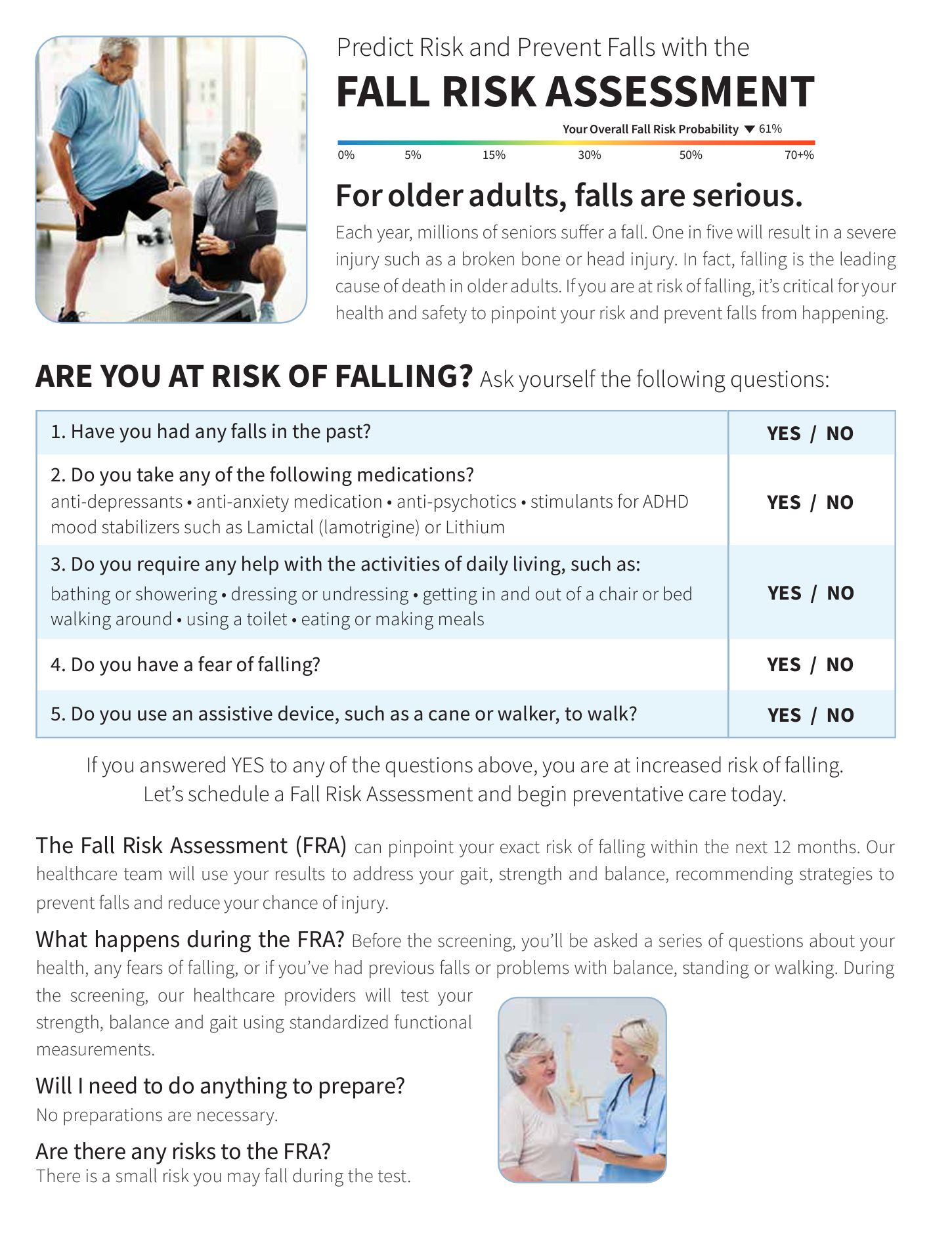The Ultimate Guide To Dementia Fall Risk
Things about Dementia Fall Risk
Table of ContentsHow Dementia Fall Risk can Save You Time, Stress, and Money.The 3-Minute Rule for Dementia Fall RiskDementia Fall Risk Fundamentals ExplainedThe Ultimate Guide To Dementia Fall Risk
A loss threat analysis checks to see exactly how likely it is that you will drop. It is mainly done for older adults. The analysis generally includes: This consists of a series of questions about your total health and wellness and if you've had previous falls or troubles with equilibrium, standing, and/or walking. These tools test your strength, equilibrium, and gait (the method you walk).STEADI consists of screening, assessing, and treatment. Interventions are referrals that may reduce your danger of falling. STEADI consists of three actions: you for your risk of succumbing to your risk variables that can be enhanced to attempt to avoid drops (for example, equilibrium problems, damaged vision) to reduce your threat of falling by utilizing effective methods (as an example, supplying education and resources), you may be asked numerous concerns consisting of: Have you fallen in the past year? Do you really feel unsteady when standing or walking? Are you stressed over falling?, your provider will certainly check your stamina, equilibrium, and gait, utilizing the adhering to fall evaluation devices: This examination checks your gait.
You'll rest down once more. Your provider will check how much time it takes you to do this. If it takes you 12 seconds or more, it might indicate you are at greater risk for a fall. This test checks strength and balance. You'll sit in a chair with your arms crossed over your upper body.
The placements will certainly obtain more challenging as you go. Stand with your feet side-by-side. Relocate one foot halfway forward, so the instep is touching the large toe of your various other foot. Move one foot completely in front of the various other, so the toes are touching the heel of your various other foot.
Facts About Dementia Fall Risk Uncovered
Most drops occur as an outcome of numerous contributing variables; for that reason, taking care of the risk of falling starts with identifying the aspects that add to fall danger - Dementia Fall Risk. Several of the most appropriate threat factors include: History of previous fallsChronic clinical conditionsAcute illnessImpaired stride and balance, lower extremity weaknessCognitive impairmentChanges in visionCertain high-risk drugs and polypharmacyEnvironmental factors can also boost the threat for falls, including: Insufficient lightingUneven or harmed flooringWet or slippery floorsMissing or harmed hand rails and get barsDamaged or incorrectly equipped devices, such as beds, mobility devices, or walkersImproper use assistive devicesInadequate supervision of individuals staying in the NF, including those that display hostile behaviorsA successful loss danger monitoring program needs an extensive professional assessment, with input from all members of the interdisciplinary team

The care plan need to also include click site treatments that are system-based, such as those that advertise a secure setting (appropriate illumination, hand rails, grab bars, and so on). Your Domain Name The performance of the treatments should be examined regularly, and the treatment plan changed as needed to reflect modifications in the fall risk evaluation. Implementing an autumn risk management system using evidence-based ideal technique can minimize the frequency of falls in the NF, while limiting the possibility for fall-related injuries.
The Best Guide To Dementia Fall Risk
The AGS/BGS guideline suggests evaluating all adults aged 65 years and older for autumn danger every year. This testing is composed of asking patients whether they have dropped 2 or even more times in the past year or sought medical attention for a loss, or, if they have not fallen, whether they feel unsteady when strolling.
People who have actually fallen when without injury needs to have their balance and gait reviewed; those with stride or balance problems should get added evaluation. A history of 1 loss without injury and without stride or equilibrium troubles does not warrant further assessment beyond continued yearly loss threat testing. Dementia Fall Risk. A fall risk analysis is needed as component of the Welcome to Medicare examination

How Dementia Fall Risk can Save You Time, Stress, and Money.
Recording a drops background is just one of the top quality indicators for loss avoidance and monitoring. A Recommended Reading critical component of threat evaluation is a medication review. Several courses of drugs raise autumn danger (Table 2). Psychoactive medications particularly are independent forecasters of drops. These medications have a tendency to be sedating, change the sensorium, and impair balance and stride.
Postural hypotension can usually be relieved by lowering the dosage of blood pressurelowering medications and/or quiting medicines that have orthostatic hypotension as a negative effects. Use above-the-knee support hose and resting with the head of the bed raised might likewise decrease postural decreases in high blood pressure. The recommended aspects of a fall-focused checkup are received Box 1.

A pull time better than or equal to 12 seconds recommends high fall danger. The 30-Second Chair Stand examination assesses reduced extremity stamina and balance. Being incapable to stand from a chair of knee elevation without using one's arms shows raised loss threat. The 4-Stage Balance examination analyzes fixed equilibrium by having the client stand in 4 placements, each considerably more challenging.